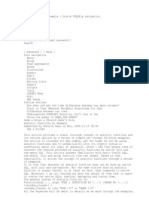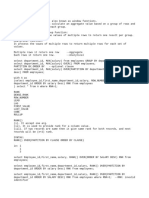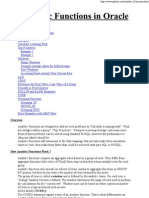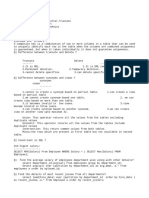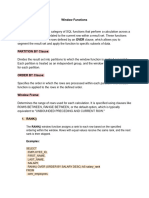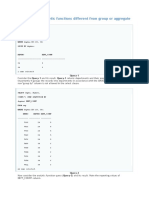0% found this document useful (0 votes)
303 views16 pagesOracle Analytic Functions Session1
This document provides an introduction to Oracle Analytic Functions. It discusses how analytic functions enhance result sets without altering the original table. Some key analytic functions covered include ROW_NUMBER, RANK, DENSE_RANK, LEAD, LAG, FIRST_VALUE, LAST_VALUE, FIRST and LAST. The document explains how to use PARTITION BY to break results into groups, ORDER BY to specify sort order, and how analytic functions differ from regular aggregation functions. Examples are provided to illustrate how each function works and how they can be used to analyze results in different ways without rewriting queries or joins.
Uploaded by
YeduCopyright
© Attribution Non-Commercial (BY-NC)
We take content rights seriously. If you suspect this is your content, claim it here.
Available Formats
Download as PPTX, PDF, TXT or read online on Scribd
0% found this document useful (0 votes)
303 views16 pagesOracle Analytic Functions Session1
This document provides an introduction to Oracle Analytic Functions. It discusses how analytic functions enhance result sets without altering the original table. Some key analytic functions covered include ROW_NUMBER, RANK, DENSE_RANK, LEAD, LAG, FIRST_VALUE, LAST_VALUE, FIRST and LAST. The document explains how to use PARTITION BY to break results into groups, ORDER BY to specify sort order, and how analytic functions differ from regular aggregation functions. Examples are provided to illustrate how each function works and how they can be used to analyze results in different ways without rewriting queries or joins.
Uploaded by
YeduCopyright
© Attribution Non-Commercial (BY-NC)
We take content rights seriously. If you suspect this is your content, claim it here.
Available Formats
Download as PPTX, PDF, TXT or read online on Scribd
/ 16


